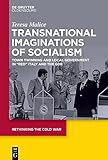Transnational Imaginations of Socialism : Town Twinning and Local Government in “Red” Italy and the GDR / Teresa Malice.
Material type: TextSeries: Rethinking the Cold War ; 6Publisher: München ; Wien : De Gruyter Oldenbourg, [2022]Copyright date: ©2023Description: 1 online resource (X, 415 p.)Content type:
TextSeries: Rethinking the Cold War ; 6Publisher: München ; Wien : De Gruyter Oldenbourg, [2022]Copyright date: ©2023Description: 1 online resource (X, 415 p.)Content type: - 9783110667264
- 9783110667424
- 9783110670950
- 945.092/6 23
- DG577.5 .M324 2023
- online - DeGruyter
- Issued also in print.
| Item type | Current library | Call number | URL | Status | Notes | Barcode | |
|---|---|---|---|---|---|---|---|
 eBook
eBook
|
Biblioteca "Angelicum" Pont. Univ. S.Tommaso d'Aquino Nuvola online | online - DeGruyter (Browse shelf(Opens below)) | Online access | Not for loan (Accesso limitato) | Accesso per gli utenti autorizzati / Access for authorized users | (dgr)9783110670950 |
Browsing Biblioteca "Angelicum" Pont. Univ. S.Tommaso d'Aquino shelves, Shelving location: Nuvola online Close shelf browser (Hides shelf browser)
Frontmatter -- Contents -- Acknowledgments -- Introduction -- Chapter 1 Conceptual Foundations and Historiographical Debates -- Chapter 2 Cold War Entanglements -- Chapter 3 Strategies of National Bilateral Exchange -- Chapter 4 “Red” Areas and Towns: Developments, Similarities, Asymmetries -- Chapter 5 Protagonists and Practices of Socialist Twinning -- Chapter 6 Looking at the “Other” -- Epilogue -- List of Archives -- List of Abbreviations -- List of Interviews -- Biographies of Interviewees -- Bibliography -- Index
restricted access online access with authorization star
http://purl.org/coar/access_right/c_16ec
Town twinning refers to the postwar phenomenon of administrative exchange between analogous municipalities. Cold War-related research has mostly interpreted it as an instrument to pursue European integration, or to solidify détente "from below". However, municipalities were not only administrative, neutral actors, but also bearers of political content. This is particularly visible in the case of Italian towns located in the Western bloc, guided by socialist-oriented administrations, and their "twin" counterparts in the German Democratic Republic. This volume explores the connections initiated by such towns in the 1960s-1970s, focusing on socialist-specific conceptions which fueled the policies implemented by "red" municipalities, in managing local economies and social policies, but also in maintaining a lively and interconnected transnational microsociability among grassroots activists. Despite the increasing ideological divergences between Eastern and Western communists, and between Italian democratic communists and the more dogmatic and repressive, strictly pro-Soviet ones in the GDR, communication continued to flourish on the local level. The book explores what still linked the two worlds together, the "bright side of socialism": in this case, a common symbolism related to the past, practical exchanges in the present dimension, and a shared future imagination and conception of the town on the basis of a socialist horizon, built around welfare and services for citizens and workers.
Issued also in print.
Mode of access: Internet via World Wide Web.
In English.
Description based on online resource; title from PDF title page (publisher's Web site, viewed 29. Mai 2023)









